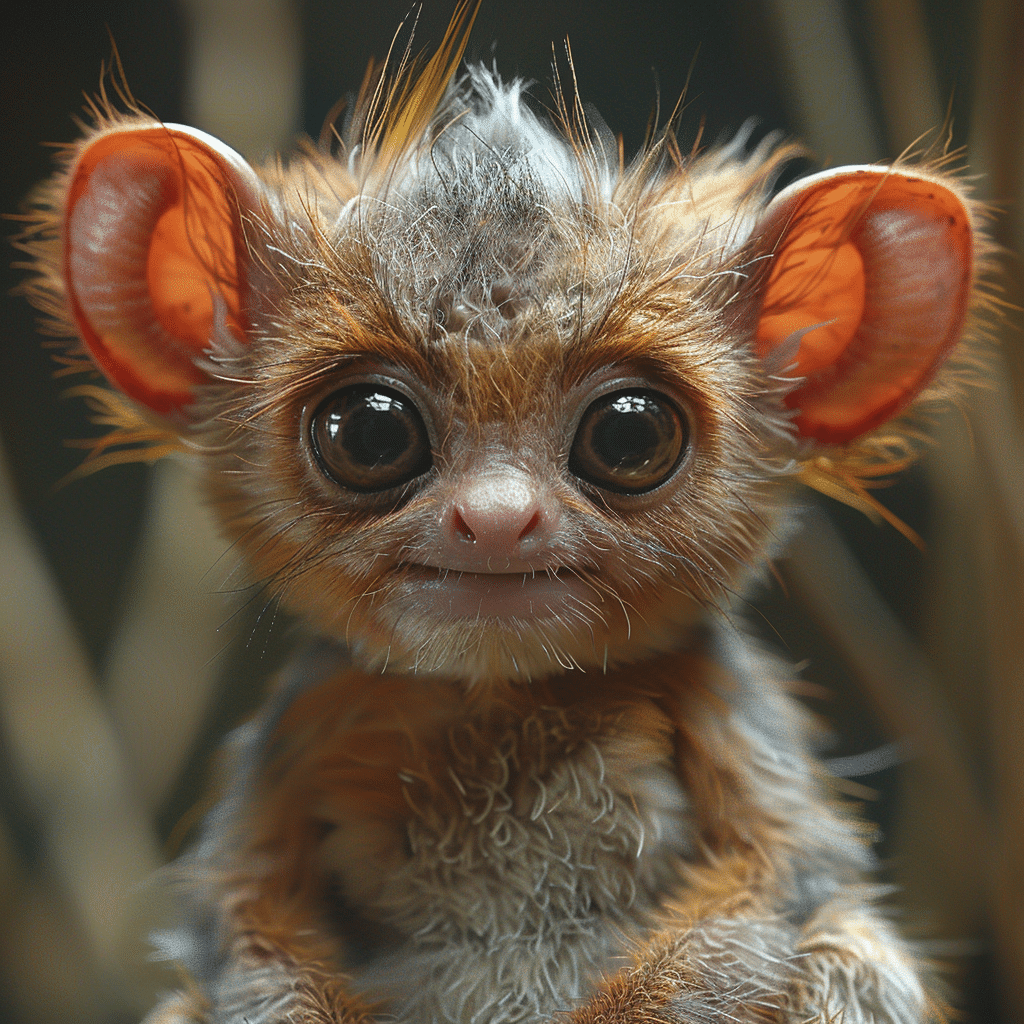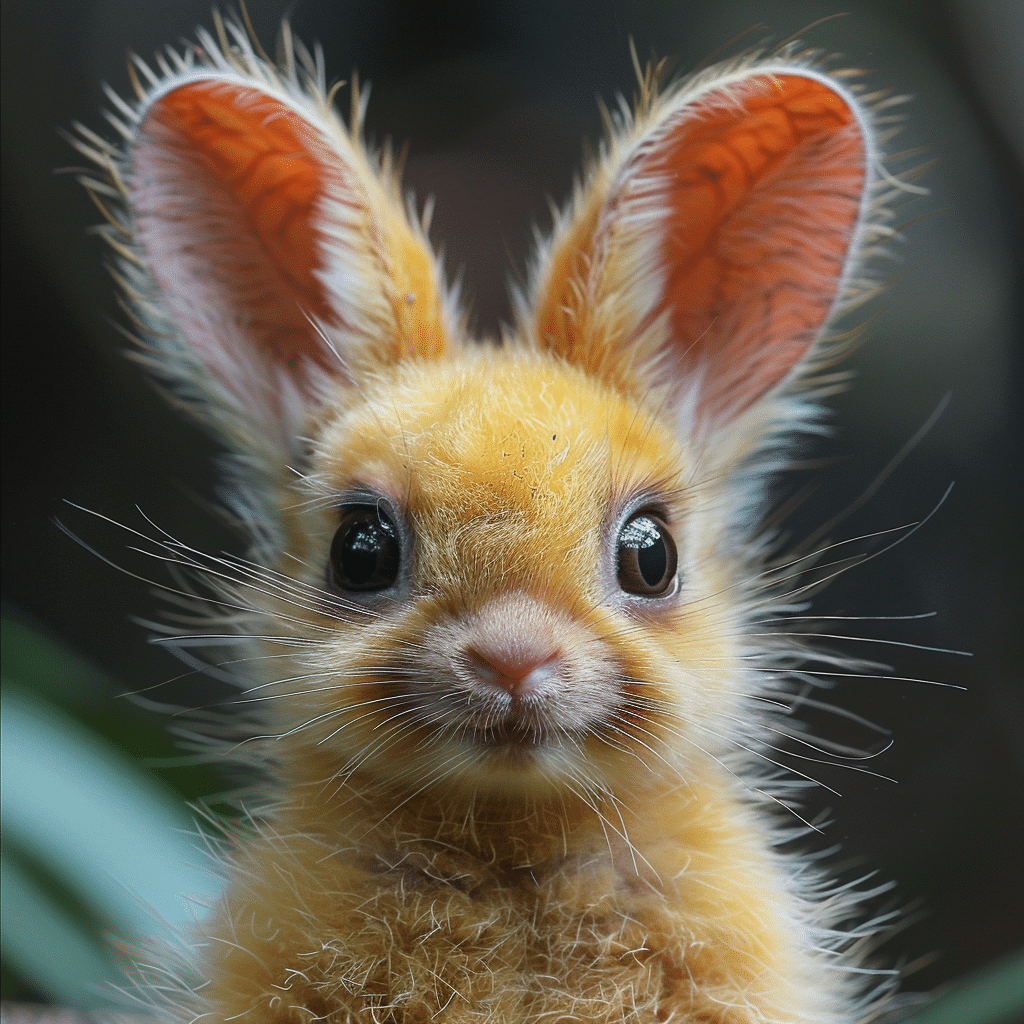Unveiling the Mysteries of Sloth Ears
In the lush canopies of the tropical rainforests, an enigmatic creature ambles through life in the slow lane. Sloths, with their leisurely pace and laid-back demeanor, have charmed animal enthusiasts worldwide. But, beyond their adorable expressions, lies an anatomy ripe with peculiar wonders—especially when it comes to sloth ears. These small, inconspicuous features are more than meets the eye, and it’s high time we tuned in to their story.
Fact 1: The Enigmatic Structure of Sloth Ears
Beyond the Silence: How Sloth Ears are Configured
Tucked away under their shaggy fur, sloth ears are essentially elusive to the untrained eye. Their ears are small, flat, and quite unremarkable at first glance, reminiscent of the ears of their evolutionary relatives, the anteaters and armadillos. But, within these rudimentary structures, lies a keen auditory system. Sloths possess a well-developed inner ear, allowing them to navigate their arboreal world with surprising precision, despite their seeming indifference to the hustle and bustle around them.
These ears are essential not only for communication with other sloths but also for detecting the subtler sounds of potential predators lurking or the soft rustling of leaves that signal a new path to travel. While they would hardly stand out in a green land skateboard campaign, sloth ears have an inimitable charm all their own.

| Category | Description |
|---|---|
| Scientific Name | Two-toed sloths (Choloepus spp.), Three-toed sloths (Bradypus spp.) |
| Physical Description | Sloths possess a small and flat head with a snub nose, rudimentary ears, and large eyes. Their body includes a short neck and four long limbs of almost equal length, with 2-toed species having two fingers and 3-toed species having three fingers on their front limbs, but all have three toes on their hind limbs. |
| Ear Characteristics | Sloths have small, rudimentary external ear structures (pinnae), which are not prominent or visible through their thick fur, and are less developed compared to other mammals. |
| Hearing Abilities | Despite having small ears, sloths can detect sounds but their hearing capabilities are not as acute as those of many other mammals; they rely more on their vision and sense of touch to navigate through their arboreal habitat. |
| Conservation Status | According to the IUCN Red List, all six species of sloths are experiencing a population decrease. The pygmy sloth (Bradypus pygmaeus) is critically endangered with only about 100 individuals remaining on Isla Escudo de Veraguas, Panama. |
| Behavior | Known for their slow movement, sloths are among the slowest-moving animals on earth, moving at a pace of about 2 meters per minute. This slow metabolism and movement help energy conservation and camouflage from predators. |
| Habitat | Sloths are arboreal, living primarily in the tropical rainforests of Central and South America. Their physiology and behavior are adapted for an upside-down lifestyle in the trees. |
| Dietary Habits | Sloths are herbivores with diet mainly consisting of leaves, twigs, and fruits, which they slowly metabolize and digest due to their low metabolic rate. |
| Reproduction | Sloths have a low reproductive rate, giving birth to typically one offspring after a six-month gestation period for 2-toed sloths or a four to five-month gestation for 3-toed sloths. The offspring cling to their mother’s fur for several months before becoming independent. |
Fact 2: The Auditory Capabilities of Sloths
Can Sloths Hear the Faintest Whispers of the Forest?
Imagine a world where the cacophony of a “kingdom hall of Jehovah’s Witnesses” meeting or the roar of a “Premier League Summer Series” game is replaced by the gentle symphony of the rainforest. Such is the world of a sloth, where their auditory world is filled with the soft hums and discreet clamors of life in the trees.
Studies have shown that despite the limited scope of their auditory structures, sloths have a profound sense of hearing. The rustle of leaves, gentle drips of rain, even the softest cries of their young—nothing escapes their notice. On the other hand, louder sounds, such as what one might experience during a “Fencing Time Live” event or the unfortunate occurrence like a “Fort Worth shooting today,” may be outside their immediate concern, but the sensitivity of their perception in quieter conditions remains impressive.
Their hearing is not always about the volume but rather the type of sound. High-pitched tones, for example, are less detectable to a sloth’s ear, while lower frequencies common in their natural environment are highly discernible. This selective hearing is perfect for a life among the canopies, as it filters out irrelevant noises and focuses on what’s important for their survival.
Fact 3: The Impact of Environment on Sloth Ears
The Rainforest’s Whisper: Essential to Sloth Auditory Health
Sloths spend their lives surrounded by the dense foliage and constant moisture of the rainforest—a stark contrast to the arid “Lows of Orkney.” Their ears, despite being small, are ingeniously designed to cope with such a humid environment. Without the need for traditional Irish clothing to shield them from the elements, sloth ears utilize a modest layer of fur to keep out excessive moisture that could otherwise lead to infection.
The sloth’s environment plays a pivotal role in the health and functionality of their ears. Comparable to humans relying on the services of a space coast credit union for their financial wellbeing, sloths depend entirely on the nurturing ambiance of the rainforest for their auditory health. The canopy’s inherent moisture resistance and the absence of contaminating elements are akin to a natural insurance policy, safeguarding the delicate inner workings of their ears.

Fact 4: The Curiosities in Sloth Ear Care and Maintenance
Natural Self-Cleaning: A Sloth’s Personal Grooming Routine
Sloth ear care is something that doesn’t trend on social media like “Britney Spears’ feet,” but these creatures have a far more intriguing hygiene routine. In the absence of a mirror or vanity table, sloths have a natural self-cleaning mechanism. Their ears secrete a wax that prevents the buildup of debris and repels water, safeguarding against infections that could lead to serious consequences in their remote environment.
What’s more, sloths occasionally engage in mutual grooming behaviors, which can help maintain their ear health. Using their long claws, they’ll gently clean around and behind each other’s ears in a carefully choreographed dance of personal care. This behavior isn’t just about hygiene; it also strengthens social bonds between sloths—their version of a binding spell of friendship.
Fact 5: The Intriguing Development From Baby Sloths to Adults
From Cuddly Infants to Majestic Canopy Dwellers
Baby sloths, or what the “England lads” of the animal kingdom might call “the cutest fuzzballs around,” possess ears that are relatively smaller and less defined than those of adult sloths. As they grow, their ears become more pronounced, although they remain small relative to the size of their round heads.
During this development, baby sloth ears are even more protected by the nurturing behavior of the mother sloth, similar to how a parent might care for their “build a bear frog”-clad child. In these early stages of life, baby sloths are extremely vulnerable, and maintaining ear health is crucial for their overall well-being.
As they mature, sloths not only gain a greater control of their auditory faculties but also a heightened awareness of their environment. This increased sensitivity is critical for survival, akin to a Go game player developing strategy skills or an artist perfecting the “Dolly Parton 1970s” look. The adaptation of their ears plays a key role as they transition from helpless infants to independent adults, navigating the delicate balance of life in the trees.
Conclusion: Embracing the Hidden Marvels
Sloth ears, much like the enigma of “William Wallace’s sword,” are emblematic of the remarkable intricacies woven into the tapestry of the natural world. They remind us that unfathomable splendor lies not only in the culturally celebrated, such as the flamboyance of a Lady Gaga costume or the mysterious allure of alleged skinwalker dogs, but also in the understated elegance of evolution’s designs.
This exploration of sloth ears has drawn back the curtain on an aspect of these captivating animals that often goes unnoticed. It has shown us that understanding and appreciating these silent, yet potent anatomical features can enrich our view of biodiversity and the intrinsic value it holds. The world of sloths with their inconspicuous ears, leisurely demeanor, and brilliant adaptations, is a potent reminder of the awe-inspiring complexity of life on our planet.
As we turn away from the constant bombardment of our conventional environments, where news of ac milan Vs Psg player Ratings, Borussia dortmund Vs Psg Stats, or the latest Kim Kardashian sex tape saga fill the airwaves, let us incline our own ears to nature’s whispers. In doing so, we resonate with the underlying ethos of CWM News, striving to unearth the untold, the profound, and the genuinely stirring. From the microcosm of sloth ears to the magnificent expanse of biodiversity that embraces us, every discovery is a note in the opus of our shared existence.
Unheard-of Facts: The Inside Scoop on Sloth Ears
Have you ever pondered the peculiar world of sloth ears? We’re not pulling your leg – these little-listened-to appendages are a treasure trove of weird and wonderful trivia! So, buckle up as we unveil some ear-ily surprising facts that’ll have you listening more closely the next time you’re hanging around these laid-back creatures.
A Symphony of Silent Sounds
First things first, man, sloths aren’t known to pump up the volume. Unlike the raucous Kids And Their management of sound, sloths keep it on the down-low. Their ears are small and tucked away, blending into their fur like a well-camouflaged secret. Whisper it, but sloths barely use their ears for communicating. They’re more about that chill life where the less noise, the better.
Louder Than a Sloth Shout
Hang on to your hats, because this might just blow your mind – or ears! Despite their preference for peace and quiet, when it’s time to express themselves, a sloth’s call can pack a punch. They’re not driving the sound waves like Shani Louk in a video truck, but if a mama sloth calls her baby, it’s a cry that cuts through the forest cacophony. Now, isn’t that just the darnedest thing?
Clean Ears, No Fears
Well, ain’t this the truth – sloths keep their ears cleaner than a whistle! Are you picturing it? A sloth tidying up, reminding us of those meticulous Women That absolutely suck at Tolerating mess. No earbuds required for these slowpokes; they maintain pretty pristine ear canals, despite the laid-back persona that suggests otherwise.
The Path Not Taken
If you think the road to understanding sloth ears is straightforward, guess again. It’s more like trying to decipher the Ac Milan Vs Psg timeline – full of twists, turns, and unexpected details. Their internal ear structure is a tad unusual, considering their arboreal lifestyle. It’s not just about hearing; it’s an integral part of how they keep their balance while maneuvering through the treetops!
Ears to the Ground
Alright, so they might not actually put their ears to the ground, but sloths still hear what’s happening around them. Their auditory prowess might not make the highlight reel like the Union Berlin Vs Real madrid Standings, but it’s pretty impressive given their small ear size. They can pick up the subtlest of forest sounds, alerting them to potential danger or the presence of fellow tree-huggers.
An Earful of Emotion
Believe it or not, sloths have their own version of “The Drop” – not of the movie kind, though it’s just as epic. When sloths are emotionally stirred, say, by a predator or a particularly delectable leaf, their Ears give a tiny twitch – it’s the sloth way of dropping the beat. It could be so slight, you’d miss it if you blinked, but it’s their special little sign that something’s up.
Isn’t Mother Nature something else? Who knew that there was so much to discover about the sloth life and sloth ears? These critters don’t just take life at a slower pace; they’ve got their own unique style and a bunch of quirky attributes that make us appreciate the animal kingdom’s diversity all the more. Next time you’re out and about, tilt your head, lend an ear and think about our sloth buddies – the kings and queens of leisure with a whole lot of ear secrets.

Do sloths have ears?
– Well, don’t let their snub nose fool ya—sloths do have ears, alright, but they’re ‘rudimentary’, which is just a fancy way of saying they’re simple and not so easy to spot. They aren’t flapping in the breeze or anything, since they’re hidden beneath all that groovy fur.
Do sloths have bad hearing?
– Bad hearing? Not exactly. While you won’t catch sloths jamming out to the latest tunes, they’ve got hearing that does the trick for their slow-paced lifestyle. Just don’t expect them to win any awards for their eavesdropping skills!
How well can sloths hear?
– Oh boy, sloths can hear alright, but let’s just say they won’t be overhearing any whispered secrets anytime soon. They have just what they need to get by up in the treetops, but you won’t find them sporting a pair of headphones anytime soon.
Are two toed sloths deaf?
– Deaf, they ain’t! Two-toed sloths might be chill, but they haven’t tuned out completely. They’ve still got their hearing, even if they’re not gonna need earplugs for the sounds of the forest.
What are sloths ears like?
– When it comes to ears, sloths are more about function than fashion. Their ears are basic and hidden away, but hey, when you’re a sloth, it’s not like you need to be listening for your cue in a Broadway show, right?
Are there only 100 sloths left?
– Hold your horses—it’s not all sloths we’re talking about here. It’s the pygmy sloth that’s super rare, with around 100 of these laid-back critters chilling on their island home off Panama. But for sloths in general? There’s more than just a handful left in the wild!
How intelligent are sloths?
– Intelligence is a tough nut to crack with these slowpokes. Sloths aren’t winning any Nobel Prizes, but they’re brainy in their own way. Survival smarts? Check. But don’t expect them to solve any algebra problems.
Why do sloths cry?
– Cry me a river—or in the sloth’s case, just a tiny one. Sloths aren’t really sobbing up there; any tears you see have more to do with eye health than a heartbreak. It’s their body’s way of keeping their peepers in tip-top shape.
What are sloths weaknesses?
– Weaknesses, huh? Sloths aren’t exactly superhero material with their slow-mo lifestyle. Their strength isn’t sprinting to the rescue, and they could use a boost in the immunity department. But they’re ace at hanging around and digesting leaves, so there’s that!
What is sloth sin?
– Sloth sin? That’s one of those old-school terms meaning ‘laziness.’ But don’t take it to heart—it’s not like sloths are lounging around committing sins. They’re just living life in the slow lane by nature’s design!
What is the sin of sloth behavior?
– The sin of sloth behavior? That’s all about being a couch potato, avoiding work or effort. Humans got the idea from watching these critters, thinking they’re all about lazy days. But remember, what looks like laziness in humans is just survival for sloths.
Do sloths like human contact?
– Like human contact? Nah, not really. Sloths are solo performers, preferring the quiet life without the fanfare and high fives. They do their own thing, and that’s just how they like it.
Why can’t you touch sloths?
– Touching sloths is a no-go, and it’s not because they’re stuck-up. They’re just not made for cuddling with us humans. Our germs are no joke for them, and stress is a big deal—plus they’ve got those long claws that aren’t exactly made for petting.
Are sloths 3x stronger than humans?
– Stronger than us? In a sloth vs. human arm-wrestling match, don’t bet on the sloth. They might be good at clinging on for dear life, but they don’t pack the same punch as us in the muscle department.
Why did sloths go blind?
– Go blind? That’s a tall tale. Sloths still have their peepers, but they won’t be winning any staring contests. Blindness isn’t part of their typical lifestyle; they’re just minding their own sloth business in the canopy.
Do sloths have ears or tails?
– Sloths are sporting both ears and tails, though we’re not talking elephant ears or peacock tails here. Everything’s on the down-low, with petite tails and ears that play it cool under all that fur.
What special senses do sloths have?
– Special senses, you say? Well, sloths are sorta like superheroes with their slow motion powers. They may not have sonar or x-ray vision, but their senses are honed for a tree-hanging, leaf-munching, chillaxed life.
Where do sloths pee?
– Where do they take a tinkle? Sloths are the epitome of convenience—they go pee right where they are, dangling in the trees! Let gravity do the work, right? But, believe it or not, they sometimes take the trouble to climb down to the ground for a proper bathroom break.
What do sloths use their ears for?
– Ear, ear, what’s the big deal? Sloths’ ears aren’t out there making headlines or anything. They’re kept on the DL, wrapped up in fur, and just doing enough to pick up on the jungle vibes around them.



